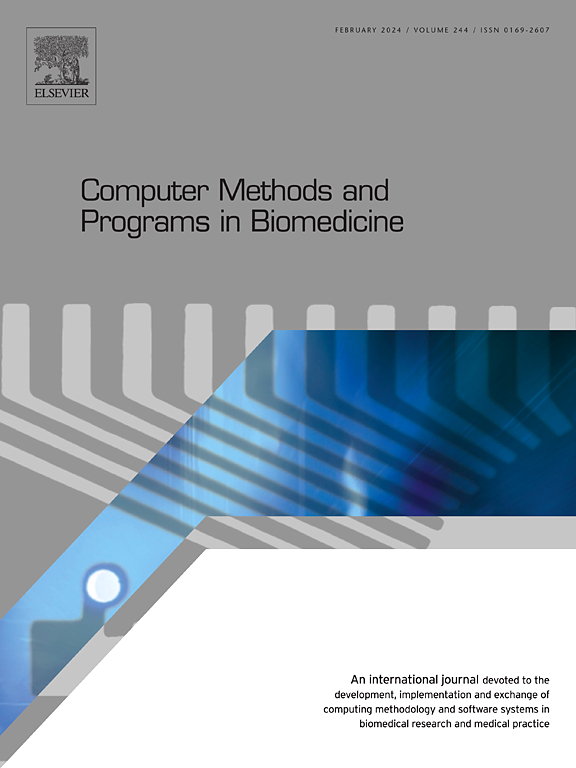Optimization of primary screw stability in Trabecular bone using neural network-based models
IF 4.9
2区 医学
Q1 COMPUTER SCIENCE, INTERDISCIPLINARY APPLICATIONS
引用次数: 0
Abstract
Background and Objective
Screw implant stability in bone is crucial to the success of many orthopaedic procedures, yet the relationship between screw design parameters and specific bone characteristics remains underexplored. This study aims to optimize screw designs to enhance primary stability by leveraging subject-specific bone data and advanced surrogate modelling techniques.
Methods
In this study, 2880 screw pull-out simulations were conducted to assess primary screw stability by analysing pull-out stiffness and strength. The resulting dataset was used to develop surrogate models using multiple linear regression, random forest, and neural networks (NN). An optimization process was then applied to find optimal screw designs for 80 distinct trabecular bone specimens, in terms of inner diameter, pitch, and thread angle.
Results
The models, trained with various input parameters, including bone morphological parameters and computed tomography images, promisingly predicted the results of the simulations. The prediction errors varied by model type, with multiple linear regression yielding approximately 12 % error, while non-linear machine learning models achieved lower errors, ranging between 2–6 %. The series of subsequent optimization tasks provided optimized screw designs showing statistically significant improvements in pull-out stiffness and strength compared to the average screw designs (approximately 16 and 14 %, respectively). This even though our study focused only on screw design parameters that generally have a smaller impact on stability compared to factors such as screw outer diameter and insertion depth.
Conclusions
Multiple linear regression models were found to be insufficient for generating optimized screw configurations, and more complex surrogate models, such as NN, are needed. It could be concluded that different trabecular bone morphologies can benefit from distinct optimal screw designs. The insights gained from this study could have implications for the development of patient-specific orthopaedic treatments.
基于神经网络的模型优化小梁骨初级螺钉稳定性
背景与目的螺钉植入物在骨内的稳定性对许多骨科手术的成功至关重要,但螺钉设计参数与特定骨特征之间的关系仍未得到充分探讨。本研究旨在优化螺钉设计,通过利用受试者特定的骨骼数据和先进的替代建模技术来增强初级稳定性。方法在本研究中,通过2880个螺钉拔出模拟,通过分析拔出刚度和强度来评估初级螺钉的稳定性。结果数据集用于使用多元线性回归、随机森林和神经网络(NN)开发代理模型。然后应用优化过程在内径、节距和螺纹角度方面为80种不同的小梁骨标本找到最佳螺钉设计。结果该模型使用多种输入参数(包括骨形态参数和计算机断层扫描图像)进行训练,能够很好地预测模拟结果。预测误差因模型类型而异,多元线性回归的误差约为12%,而非线性机器学习模型的误差较低,在2 - 6%之间。随后的一系列优化任务提供了优化的螺钉设计,与普通螺钉设计相比,统计上显着提高了拔出刚度和强度(分别约为16%和14%)。尽管我们的研究只关注螺钉设计参数,与螺钉外径和插入深度等因素相比,这些参数通常对稳定性的影响较小。结论多元线性回归模型不足以产生最优的螺杆构型,需要更复杂的替代模型,如神经网络。结论:不同的骨小梁形态可受益于不同的最佳螺钉设计。从这项研究中获得的见解可能会对患者特异性矫形治疗的发展产生影响。
本文章由计算机程序翻译,如有差异,请以英文原文为准。
求助全文
约1分钟内获得全文
求助全文
来源期刊

Computer methods and programs in biomedicine
工程技术-工程:生物医学
CiteScore
12.30
自引率
6.60%
发文量
601
审稿时长
135 days
期刊介绍:
To encourage the development of formal computing methods, and their application in biomedical research and medical practice, by illustration of fundamental principles in biomedical informatics research; to stimulate basic research into application software design; to report the state of research of biomedical information processing projects; to report new computer methodologies applied in biomedical areas; the eventual distribution of demonstrable software to avoid duplication of effort; to provide a forum for discussion and improvement of existing software; to optimize contact between national organizations and regional user groups by promoting an international exchange of information on formal methods, standards and software in biomedicine.
Computer Methods and Programs in Biomedicine covers computing methodology and software systems derived from computing science for implementation in all aspects of biomedical research and medical practice. It is designed to serve: biochemists; biologists; geneticists; immunologists; neuroscientists; pharmacologists; toxicologists; clinicians; epidemiologists; psychiatrists; psychologists; cardiologists; chemists; (radio)physicists; computer scientists; programmers and systems analysts; biomedical, clinical, electrical and other engineers; teachers of medical informatics and users of educational software.
 求助内容:
求助内容: 应助结果提醒方式:
应助结果提醒方式:


